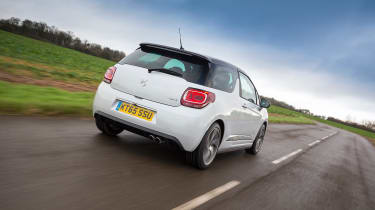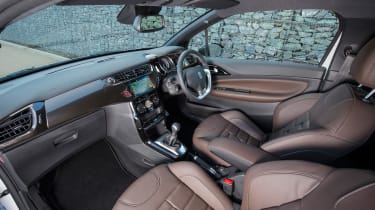New DS 3 2016 review
We drive the revised DS 3 supermini for the first time. Can this six-year old car still face up to the Polo and Fiesta?

The DS 3 may be six years old, but it doesn’t feel remotely dated to drive, while the visual changes freshen up the exterior look and cabin design nicely. Whether you prefer the modern glamour of this or the retro chic of the MINI is subjective, but the DS is more practical and nicer to drive than the Fiat 500. Prestige spec isn't cheap, however, and interior quality is disappointing in places. The diesel is a fine choice, but the more charismatic Puretech petrols would be our pick.
While DS as a brand may be finding its feet, there’s one car in its range that has a firmly established following already. The DS 3 supermini has been a quiet success story for parent company Citroen, with 390,000 sold globally since 2010. Over 100,000 of those were registered in the UK, and we are now the biggest market for the DS 3 – even overtaking France. The numbers are so impressive that we’re getting to sample it on the road even before those in its native land.
After a quick badge change last year to mark the launch of DS as a separate outfit, this brings the DS 3 into line with the DS 4 and DS 5. The front-end gets the new hexagonal corporate face and LED lights, while at the rear the designers have tweaked the tail-lamps. New alloy wheel designs and extra personalisation options complete the package.
The updates are largely successful despite its advancing years, and the DS 3 remains a smart and modern design that goes against the Marmite-esque MINI and Fiat 500. That said, there’s 78 different exterior colour combinations, 10 roof decals and over three-million different blends of spec and colour. It allows you to make a DS 3 that is truly unique.
Inside, visual changes are limited to new upholstery and trim designs, but the most welcome addition is fresher tech – in the form of PSA’s latest-generation seven-inch touchscreen infotainment and nav system. It brings Apple CarPlay and Mirrorlink tech, too.
The benefit is less clutter; there’s 20 fewer buttons on the centre console and it looks far tidier. The downside is certain functions that could have been operated with a simple prod have now been relegated to a sub-menu in the touchscreen, which still isn’t the most responsive around. Still, it’s feature-packed and the display is clear, while the smart new instruments and gloss black trim give a touch of class.
The optional ‘watch-strap’ leather makes it feel truly upmarket, too, so it’s a shame that some hard plastic on the lower dash and a flimsy, undamped glovebox lid lets it down. There’s also not as much oddment stowage as you’ll find in a number of mainstream superminis, but given the style-focused brief, that’s forgivable.
Kit levels are strong, too, with our Prestige-spec car getting sat-nav, LED headlamps, cruise control, parking sensors front-and-rear and Alcantara trim. But given our diesel model costs nearly £20k before options, we wouldn’t expect anything less.
It might lose a point to the MINI in terms of practicality (there’s no five-door option), but the door opening is wide and passengers can clamber into the back easily thanks to a grab handle by the seat. Once back there, head and legroom is adequate for all but the tallest adults, as six-footers will find their head brushing the roofline. The 285-litre boot is 74 litres roomier than a MINI three-door, but the five-door is only seven litres behind. A Skoda Fabia is bigger, but at least the DS 3 is more versatile than a Fiat 500.
Some manufacturers argue that fashion-oriented small cars don’t need to be a dynamic drive, but the DS 3 has always countered that. The chassis, steering and suspension are unchanged from the outgoing DS 3, but that’s no bad thing – striking a decent (but not perfect) balance between ride comfort and agility.
Tyre roar remains noticeable on rougher roads, but it’s not intrusive and no worse than rivals in that regard. The steering is accurate, if a little slow compared to the MINI’s ultra-sharp rack, while grip levels are strong and the nose tucks into bends nicely. A MINI is undoubtedly more engaging, but the DS isn’t far behind. The ride is firm over the roughest of tarmac, but never truly uncomfortable and it's composed at speed.
Our test car came with the most powerful diesel available: the familiar 118bhp 1.6 BlueHDI unit. As before, it’s smooth, refined and, thanks to a healthy 285Nm of torque, offers strong in-gear pace. A combined economy figure of 78.5mpg and CO2 emissions of 94g/km are competitive, too. But, as with the MINI, we prefer the more characterful and rev-happy Puretech turbo petrol engine in a car like the DS 3.









